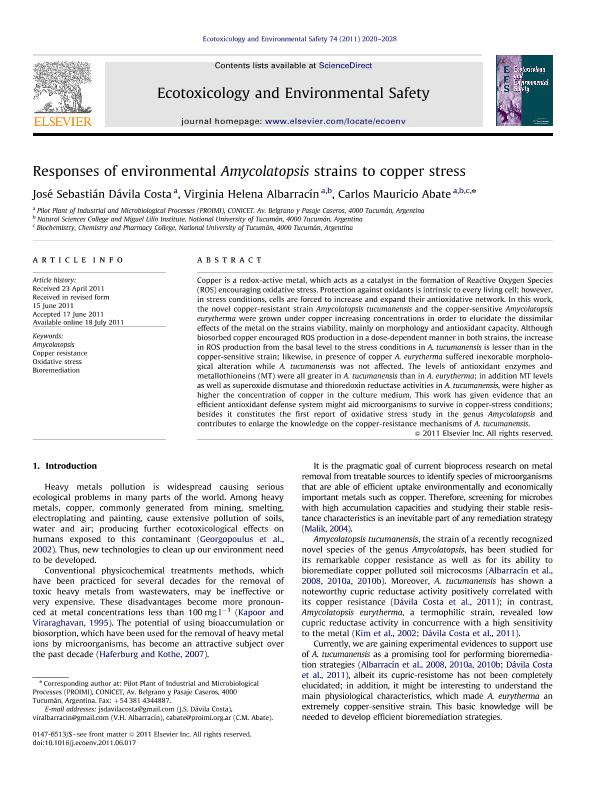Mostrar el registro sencillo del ítem
dc.contributor.author
Dávila Costa, José Sebastián

dc.contributor.author
Albarracín, Virginia Helena

dc.contributor.author
Abate, Carlos Mauricio

dc.date.available
2017-05-31T19:10:08Z
dc.date.issued
2011-07-18
dc.identifier.citation
Dávila Costa, José Sebastián; Albarracín, Virginia Helena; Abate, Carlos Mauricio; Responses of environmental Amycolatopsis strains to copper stress; Elsevier; Ecotoxicology And Environmental Safety; 74; 7; 18-7-2011; 2020-2028
dc.identifier.issn
0147-6513
dc.identifier.uri
http://hdl.handle.net/11336/17187
dc.description.abstract
Copper is a redox-active metal which acts as a catalyst in the formation of Reactive Oxygen Species (ROS) encouraging oxidative stress. Protection against oxidants is intrinsic to every living cell, however in stress conditions, cells are forced to increase and expand their antioxidative network. In this work, the novel copper-resistant strain Amycolatopsis tucumanensis and the copper-sensitive Amycolatopsis eurytherma were grown under copper increasing concentrations in order to elucidate the dissimilar effects of the metal on the strains viability, mainly on morphology and antioxidant capacity. Although biosorbed copper encouraged ROS production in a dose-dependent manner in both strains, the increase in ROS production from the basal level to the stress conditions in A. tucumanensis is lesser than in the copper-sensitive strain; likewise, in presence of copper A. eurytherma suffered inexorable morphological alteration while A. tucumanensis was not affected. The levels of antioxidant enzymes and metallothioneins (MT) were all greater in A. tucumanensis than in A. eurytherma; in addition MT levels as well as superoxide dismutase and thioredoxin reductase activities in A. tucumanensis, were higher as higher the concentration of copper in the culture medium. This work has given evidence that an efficient antioxidant defence system might aid microorganisms to survive in copper-stress conditions; besides it constitutes the first report of oxidative stress study in the genus Amycolatopsis and contributes to enlarge the knowledge on the copper-resistance mechanisms of A. tucumanensis.
dc.format
application/pdf
dc.language.iso
eng
dc.publisher
Elsevier

dc.rights
info:eu-repo/semantics/openAccess
dc.rights.uri
https://creativecommons.org/licenses/by-nc-nd/2.5/ar/
dc.subject
Amycolatopsis
dc.subject
Cobre
dc.subject
Estrés Oxidatico
dc.subject
Biorremediación
dc.subject.classification
Biología Celular, Microbiología

dc.subject.classification
Ciencias Biológicas

dc.subject.classification
CIENCIAS NATURALES Y EXACTAS

dc.title
Responses of environmental Amycolatopsis strains to copper stress
dc.type
info:eu-repo/semantics/article
dc.type
info:ar-repo/semantics/artículo
dc.type
info:eu-repo/semantics/publishedVersion
dc.date.updated
2016-02-05T14:59:40Z
dc.journal.volume
74
dc.journal.number
7
dc.journal.pagination
2020-2028
dc.journal.pais
Países Bajos

dc.journal.ciudad
Amsterdam
dc.description.fil
Fil: Dávila Costa, José Sebastián. Consejo Nacional de Investigaciones Científicas y Técnicas. Centro Científico Tecnológico Tucumán. Planta Piloto de Procesos Industriales Microbiológicos (i); Argentina
dc.description.fil
Fil: Albarracín, Virginia Helena. Consejo Nacional de Investigaciones Científicas y Técnicas. Centro Científico Tecnológico Tucumán. Planta Piloto de Procesos Industriales Microbiológicos (i); Argentina. Universidad Nacional de Tucumán; Argentina
dc.description.fil
Fil: Abate, Carlos Mauricio. Consejo Nacional de Investigaciones Científicas y Técnicas. Centro Científico Tecnológico Tucumán. Planta Piloto de Procesos Industriales Microbiológicos (i); Argentina. Universidad Nacional de Tucumán; Argentina
dc.journal.title
Ecotoxicology And Environmental Safety

dc.relation.alternativeid
info:eu-repo/semantics/altIdentifier/doi/http://dx.doi.org/doi:10.1016/j.ecoenv.2011.06.017
dc.relation.alternativeid
info:eu-repo/semantics/altIdentifier/url/http://www.sciencedirect.com/science/article/pii/S0147651311001813
Archivos asociados
